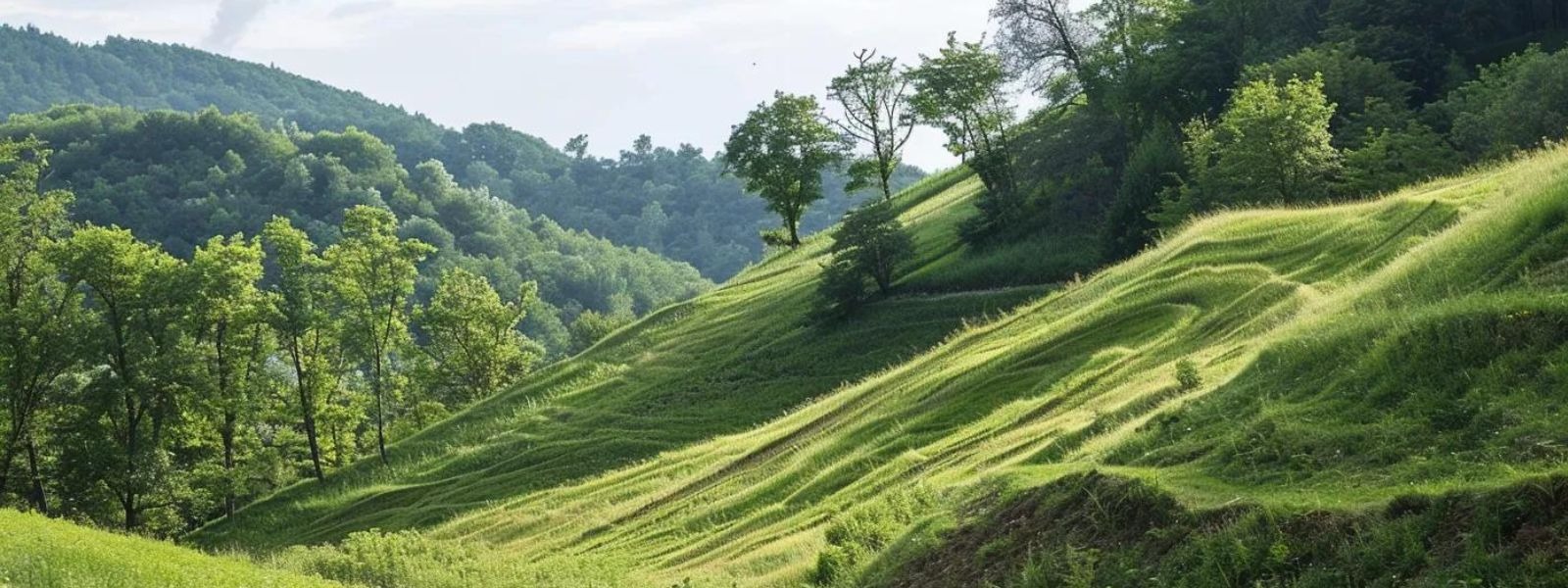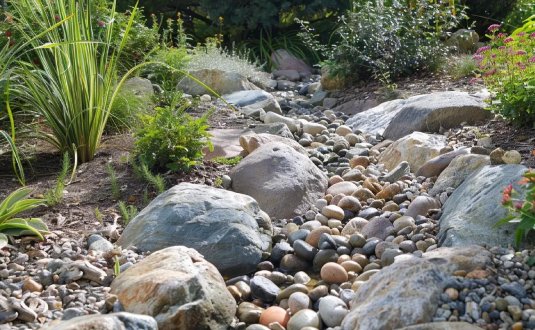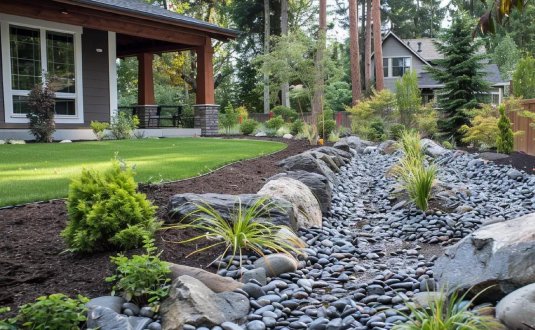Providing Best Services in Huntsville, AL
Providing Best Landscaping Services in Huntsville, AL



.webp)
Best Practices to Prevent Soil Erosion on Steep Slopes
The best practices to prevent soil erosion on steep slopes include using vegetation to anchor the soil, such as grasses, shrubs, or ground cover plants with strong root systems. Installing erosion control mats or geotextiles adds stability by holding soil in place during heavy rain. Terracing or creating small retaining walls helps slow water flow and reduce runoff speed. Mulch, gravel, and proper drainage channels also support long-term slope protection and minimize erosion.
Why Steep Slopes Lose Soil So Fast
Steep slopes face a tough battle. When it rains, water rushes down the hill instead of soaking in. This fast-moving water picks up soil and carries it away. The steeper your slope, the faster water moves and the more soil you lose.
Research shows that slopes steeper than 12% face much higher erosion risks. On very steep slopes (over 50%), soil loss can happen four times faster than on gentle slopes. That's a lot of dirt washing down the hill.
What Makes Erosion Worse
Several things speed up soil loss on steep slopes. Heavy rainfall is the biggest problem. Big storms drop tons of water all at once. Water hits the ground hard and runs fast. Bare soil makes things worse because dirt with no plants on top washes away easy. There's nothing to slow the water down or hold soil together.
Wind also plays a part. Strong gusts can blow dry soil right off a bare hillside. This happens most in areas that don't get much rain.
The type of soil matters too. Sandy soil drains fast but doesn't hold together well. Clay soil sticks together better but can get hard when it dries. Both types need help on steep slopes.
Start with Plants That Hold Soil in Place
Plants are your first line of defense. Their roots grab onto soil like tiny fingers. The leaves and stems slow down raindrops before they hit the ground. This double action stops a lot of erosion before it starts.
For slopes between 25% and 50%, plant grass, shrubs, or small trees. These create a thick root mat that binds soil particles together. When rain falls, the plants catch water and let it soak into the ground slowly.
On slopes steeper than 50%, skip the grass. It's too hard to mow and might not grip well enough. Instead, use:
- Deep-rooted ground cover plants that spread wide
- Native shrubs with strong root systems
Pick the Right Plants for Your Slope
Think about sun and shade when choosing plants. South-facing slopes get hot and dry fast. North-facing slopes stay cooler and wetter. Match your plants to these conditions.
Native plants work best. They're used to your area's weather and soil. They also need less water once they're growing. This saves you time and money.
If your slope has problems with yard erosion, start by fixing the worst spots first. Plant those areas right away to stop more damage.
Use Erosion Control Blankets for Quick Protection
Sometimes plants need time to grow. That's where erosion control blankets help. These mesh or fiber mats sit on top of your soil. They hold dirt in place while seeds sprout and roots spread.
Erosion blankets work great on slopes up to 33%. Roll them out, pin them down with stakes, and plant through the openings. The blanket stays put during rain and wind.
There are different types to choose from:
- Straw blankets for gentle slopes that break down naturally
- Coir fiber mats for steeper hills that need longer protection
Pin the blankets every few feet. Make sure the edges overlap so water can't wash under them. On very steep slopes, add extra pins to keep everything secure.
Build Terraces to Slow Water Down
Terraces are like steps cut into your hillside. They create flat areas that catch water and let it soak in. This stops runoff from picking up speed as it flows downhill.
Building terraces takes work, but they last for years. Each terrace level reduces how fast water moves. Shorter terraces in a series work better than one tall terrace.
You can make terraces from:
- Stacked rocks or treated wood timbers
- Concrete blocks or natural logs
Space your terraces 50 to 100 feet apart going down the slope. Fill each level area with good soil. Then plant grass, flowers, or shrubs on the flat parts. The plants add even more protection.
Behind each terrace wall, add gravel or a drain pipe. This helps water flow away instead of building up behind the wall. Standing water can push walls over or cause them to fail.
Install Retaining Walls for Steep Slopes

When slopes get really steep, you need stronger support. Retaining walls hold back soil and create level spaces. They work where terraces alone won't cut it.
Different types of retaining walls serve different needs:
- Gravity walls that stand by their own weight
- Tiered walls that step down the slope in sections
For walls taller than 2 feet, check local rules. You might need a permit. Professional help is smart for walls over 3 feet high. These need proper design to stay safe and stable.
Good drainage is critical. Water building up behind a wall causes major problems. Always add gravel and pipes to let water escape. This keeps pressure off the wall and makes it last longer.
White Shovel Landscapes offers hardscaping services that include retaining wall installation designed for your property's specific needs.
Try Geocells for Modern Slope Protection
Geocells are a newer option that works really well. Think of them as a honeycomb made from tough plastic. You lay the honeycomb on your slope, stake it down, and fill each cell with soil or rock.
These cells hold everything in place. Rain can flow through, but soil can't wash away. Geocells work on slopes as steep as 60 degrees. They're one of the most flexible solutions available.
Why geocells work so well:
- They support plant growth and let water drain through naturally
- They cost less than concrete and install faster than walls
Fill geocells with soil if you want plants to grow. Use rock or concrete if you need something stronger. Either way, the honeycomb structure keeps your slope stable.
Add Mulch to Gentle Slopes
For slopes under 33%, mulch is an easy fix. Spread a thick layer (3 to 4 inches) of wood chips or bark over bare soil. The mulch protects dirt from rain and wind. It also helps soil hold moisture.
Mulch works best on smaller slopes or as part of a bigger plan. Use it around plants and in garden areas. On steep slopes, the mulch can slide down, so save it for flatter spots.
Pin or tack down mulch on any slope. This keeps it from washing away during heavy rain. You can also use straw with stakes to anchor it.
Use Riprap Near Water
Riprap means big rocks placed along streams, ponds, or drainage paths. The heavy stones break up water flow and protect soil underneath. This works great where water moves fast or collects.
Place riprap at the bottom of slopes where runoff naturally flows. The rocks catch water and let it spread out slowly. They also create a barrier that stops soil from washing into water sources.
Hiring professionals for riprap makes sense. The rocks are heavy and need special equipment to place correctly. Done right, riprap lasts for decades with almost no care needed.
Set Up Proper Drainage Systems
Good drainage is just as important as holding soil in place. When water has somewhere to go, it doesn't rush down your slope tearing up soil. Smart drainage design prevents problems before they start.
Key drainage solutions that work:
- Swales (shallow ditches) and French drains (buried pipes with gravel)
- Downspout extensions that direct roof water away from slopes
Never let water from gutters dump straight onto a slope. Use extensions to carry it past bare areas to grass or a drain. This simple step stops a lot of erosion.
White Shovel Landscapes provides drainage solutions that work with your slope to manage water flow properly.
Fix Soil Quality Before Planting
Healthy soil holds together better than poor soil. Before planting or building on a slope, check what you're working with. Sandy soil needs organic matter mixed in. Clay soil needs loosening up.
Adding compost helps any soil type. It feeds plants and improves soil structure. Mix 2 to 3 inches of compost into the top layer before planting. This gives roots a good start and helps water soak in.
Test your soil's pH too. Most plants like soil between 6.0 and 7.0. If yours is too high or low, add the right amendments. Healthy plants with strong roots stop more erosion than struggling plants with weak roots.
For slopes with serious soil problems, consider professional soil amendment and repair services to get your foundation right.
Choose the Right Irrigation Method

How you water matters on slopes. Regular sprinklers send water rushing downhill, taking soil with it. Drip irrigation puts water right where plants need it without causing runoff.
Drip systems cost more upfront but save water and prevent erosion. The slow drip lets water soak deep into soil. Roots grow stronger, and no water runs off carrying dirt away.
If you must use sprinklers, run them for short periods. Let water soak in between cycles. This "cycle and soak" method gives soil time to absorb moisture without creating runoff.
Water in the early morning when possible. Less wind means water goes where you aim it. Less sun means less water evaporates before soaking in.
Maintain Your Erosion Controls
Installing erosion controls is just the start. Regular care keeps them working well for years. Check your slope after every big storm. Look for bare spots where plants died, loose blankets or mats, cracks in retaining walls, and areas where water is cutting new paths.
Fix small problems fast before they become big ones. Replant bare spots right away. Reset any stakes that worked loose. Fill in small washouts before they turn into gullies.
Trim plants to keep them healthy but don't remove too much at once. The roots need the leaves to stay strong. Cutting everything back too far weakens the whole system.
Add more mulch or compost each year. This feeds plants and replaces material that broke down. It also covers any thin spots before they become problems.
Match Methods to Slope Steepness
Different slopes need different solutions. Here's a quick guide.
For slopes under 25%, plant grass and ground cover, use mulch in garden areas, and add simple drainage. For slopes between 25% and 50%, combine plants with erosion blankets, consider short terraces, and install drip irrigation. For slopes over 50%, use retaining walls or geocells, plant deep-rooted shrubs and trees, build proper drainage systems, and skip lawn areas.
Very steep slopes (over 60 degrees) need professional design. The forces at work are strong, and failures can be dangerous. Don't guess on these projects.
Know When to Call Professionals
Some slope problems are too big for DIY fixes. Call in experts when you see large areas of bare soil washing away, cracks in the ground that keep growing, retaining walls leaning or cracking, water cutting deep channels (gullies), or standing water that won't drain.
Professionals have tools and knowledge that save you time and money in the long run. They can design systems that work together and last for decades.
A good landscape company will look at your whole property, not just the problem spot. They'll find the cause of erosion and fix it at the source. This prevents the same problem from popping up somewhere else.
White Shovel Landscapes offers comprehensive landscaping design services that include erosion control planning for steep slopes and challenging terrain.
Combine Methods for Best Results
The strongest erosion control uses several methods together. Don't rely on just one thing to solve the problem. Plants plus drainage plus proper grading work better than any single solution.
Start with the basics. First, fix drainage to move water safely off your slope. Second, improve soil quality so plants can thrive. Third, plant appropriate vegetation for your slope angle. Fourth, add physical barriers like walls or blankets where needed. Fifth, maintain everything regularly.
Think of erosion control like a team. Each player has a job, and they work together to win the game. Plants catch rain and hold soil. Drainage moves water away. Walls support steep sections. Together, they protect your slope.
Plan for Long-Term Success
Good erosion control isn't a one-time project. It's an ongoing process that changes as your slope changes. Plants mature and spread. Materials age and need replacing. Weather patterns shift over time.
Build flexibility into your plan. Use native plants that adapt to dry spells and wet years. Choose materials rated to last in your climate. Design systems that you can expand or adjust later.
Keep records of what you did and when. Take photos each season. This helps you spot changes early and track what works best on your property. Good records also help contractors understand your site better if you need professional help later.
Budget for maintenance every year. A little money spent on upkeep prevents expensive repairs later. Think of it like changing oil in your car—small regular costs avoid big breakdown bills.
Common Questions About Steep Slope Erosion
What Is the Best Plant for Steep Slopes?
Native grasses and deep-rooted shrubs work best because their roots hold soil tight. Ground cover plants that spread quickly also help protect bare areas from washing away.
How Steep Is Too Steep for Grass?
Any slope over 50% (1 foot up for every 2 feet across) is too steep for regular grass. These slopes need shrubs, ground cover, or structural solutions like retaining walls instead.
Do Erosion Blankets Really Work?
Yes, erosion blankets protect soil while plants grow and establish roots. They work great on slopes up to 33% and can reduce soil loss by over 90% during the first year.
How Much Does Slope Stabilization Cost?
Simple solutions like plants and mulch cost $500 to $2,000 for small areas. Retaining walls run $3,000 to $10,000 depending on height and materials. Professional design adds to the total cost.
Can I Fix Erosion Myself?
You can handle gentle slopes under 25% with plants, mulch, and erosion blankets. Steeper slopes or large problem areas need professional help to design proper drainage and support structures.
Final Thoughts
Protecting steep slopes from erosion takes planning and the right combination of solutions. Start with plants that hold soil with their roots. Add erosion blankets or mats for quick protection while plants establish. Build terraces or retaining walls on very steep areas. Make sure water drains properly instead of rushing down the slope.
The key is matching your method to your slope's steepness, soil type, and how much rain you get. Gentle slopes might only need good plants and mulch. Steep slopes often need walls, drainage systems, and professional design.
Don't wait for erosion to get worse. Small problems turn into big expensive ones fast. Act now to protect your property, prevent muddy yards, and keep your landscape looking great for years to come.
Ready to stop erosion on your steep slope? White Shovel Landscapes can assess your property and design a custom solution that works. Contact us today to protect your investment and enjoy a stable, beautiful landscape.
Stay Connected and Inspired
Get the latest landscaping tips, seasonal care guides, and exclusive offers delivered straight to your inbox. Don’t miss out on expert advice and ideas to transform your outdoor spaces.
Sign Up for Our Newsletter Today!


Your Next Idea Awaits
Stay inspired with our latest landscaping tips and trends.
.webp)
.webp)

.webp)
.webp)
.webp)
.webp)
.webp)

.webp)








.webp)
.webp)





